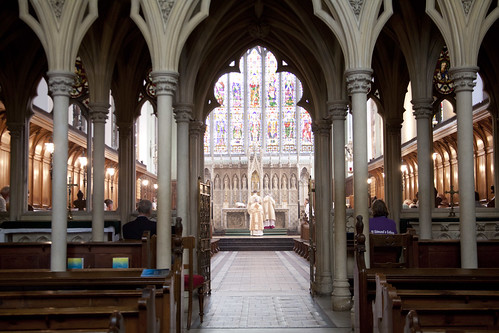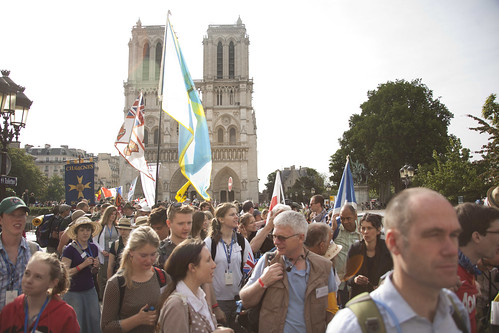 |
| The Traditional Mass through a Pugin Rood Screen, at St Edmund's College, Ware |
I've given a lot of space on this blog recently to the question about men being lost to the Church, and a reader kindly mentioned a book which notes the contrasting situation in the Orthodox Church. This is the testimony of an American, female, convert to Orthodoxy. She begins with a reminiscence about attending Vespers when she was new to it.
...
Something about Orthodoxy has immense appeal to men, and it's something that their wives--especially those used used to worshipping in the softer evangelical style---are generally slower to get. The appeal of joining this vast, ancient, rock-solid communion must be something like the appeal of joining the marines. It's going to be demand a hell of a lot out of you, and it's not going to cater to your individual whims, but when it's through with you you're going to be more than you ever knew you could be. It's going to demand, not death on the battlefield, but death to self in a million painful ways, and God is going to be sovereign. It's a guy thing. You wouldn't understand.
When I asked members of our little mission, "Why did you become a member?," two women (both enthusiastic converts now) used the same words: "My husband dragged me here kicking and screaming." Several others echoed that it has been their husband's idea--he'd been swept off his feet and had brought them along willy-willy. Another woman told me how she left Inquirer's Class each week vowing never to go again, only to have her husband wheedle her into giving it one more try; this lasted right up to the day of her chrismation [baptism]. I can imagine how her husband looked, because that's how my Gary looked: blissful, cautious, eager, and with a certain cat-who-ate-the-canary, you'll-find-out smile.
Facing East: A Pilgrim's Journey into the Mysteries of Orthodoxy, by Frederica Matthews-Green, p.xii
Facing East: A Pilgrim's Journey into the Mysteries of Orthodoxy, by Frederica Matthews-Green, p.xii
This is fascinating from the perspective of a Latin Catholic attached to the Traditional Mass. Our situation is similar, but not as extreme. This is something which the many liberal and conservative Catholics sympathetic to Orthodoxy must adjust to. The Latin Church has its own little band of staunch followers of liturgical and disciplinary tradition, with an apparently incomprehensible and partly hidden liturgy. If you think what we do is bad, should be toned down, needs a bit more of the spirit of the Bugnini Reform, what are you going to say about the Orthodox, or indeed Catholics of the Oriental Rites? And when you are praising them to the skies for their 'solidity' and exotic, contemplative liturgy and spirituality, you can note that they have not driven their men-folk out into the street, and that a similar phenomenon is happening in the context of the Traditional Mass right here in the Latin Church.
I wouldn't say that Traditional Catholic men have to drag their wives into Mass 'kicking and screaming', but it is certainly common to hear, of a couple who have discovered it, that the man took to it first.
It's a guy thing. You wouldn't understand.
In some places in the West the Orthodox are attracting many people like Frederica Matthews-Green and her husband: Evangelicals, Latin Catholics, and others. What have the Orthodox got to offer people of Latin, Western, cultural background, of which the Roman Catholic Church can't offer more?
Mrs Matthews-Green gives us the answer: the perception of a 'vast, ancient, rock-solid communion' with a liturgy which appeals, as Pope St John Paul II expressed it, not just to the intellect but to the 'human person in his totality': tota sua cum persona (Orientale Lumen (1995) 11). The combination of historical continuity, a contemplative liturgy, and a wholesome critique of the decadent secular culture: these are, of course, the very things that brought hundreds of thousands of converts into the Church in the English-speaking world in the first half of the 20th century (well over half a million between 1912 and 1960 in England and Wales alone). Perhaps giving those things up wasn't such a great idea.
Position Papers relevant to this topic are:
Liturgical Piety and Participation
The EF and Western Culture
The EF and the Eastern Churches
See my series of posts on the Eastern Churches and on the Church and Masculinity.
Position Papers relevant to this topic are:
Liturgical Piety and Participation
The EF and Western Culture
The EF and the Eastern Churches
See my series of posts on the Eastern Churches and on the Church and Masculinity.
Support the work of the LMS by becoming an 'Anniversary Supporter'.

You might find this post interesting on the subject of men and the appeal that Eastern Orthodoxy has had for them.
ReplyDeleteWhenever I have attended Orthodox liturgy (admittedly not often) there have been far more women present than men, and mostly elderly women.
ReplyDeleteSomething that appeals to men and women in more or less equal numbers is contemplative prayer, prayer of quiet and stillness - one might ponder why this is so.
I think the left are more than aware of the male attraction to the Latin Mass and the East, even if it goes unspoken. Many don't want a male church. They want liturgies presided over by both sexes (but preferably women) and ultimately female clergy. Less men equals less priests equals less male control and less Masses. This in turn necessitates more female lay-led 'communion services', more female control in the church, and eventually women priests and bishops.
ReplyDeleteThanks for the interesting article Dr Shaw. I would just like to say that while I deeply favor the Traditional Rite, I have seen Ordinary Form parishes busting at the seams, and with men, too. I live in the Diocese of Lincoln, Nebraska, and it is thriving and is flush with vocations. In a diocese of 90000 Catholics, there are more vocations per capita here than anywhere in the country. There are two seminaries, both built since 1999, and one of them is the FSSP seminary for English speaking seminarians. Every parish in Lincoln proper is bursting at the seams at Mass, often with standing room only being the only seating choice, and young priests serve each parish. The Newman Center at the University of Nebraska is building what has to be the most impressive (and gorgeous Romanesque) student chapel anywhere in the United States, complete with handcrafted stained glass windows made in Germany. As a transplant to Lincoln, and a convert to Catholicism, I can offer only this as the secret to healthy churches and robust attendance by ALL Catholics in a diocese: robust episcopal leadership. Glennon Flavin, Fabian Bruskewitz, and James Conley are the most recent three bishops here, and all have been extremely steady and orthodox Catholic bishops, willing to play hardball with secular culture and not compromising one inch on doctrine and dogma. If all bishops would behave this way, and encourage the same in their priests, Catholicism in the rest of the Western world would be booming, exactly as it is here.
ReplyDeleteA key component of the success of the Diocese of Lincoln, Nebraska, is the absence of altar girls, in which it is (I think) now unique in the USA, and I suspect the developed world.
DeleteI certainly don't deny that when consistent steps against emasculation, of which this is an outstanding example, are taken in the context of the Ordinary Form, this makes a huge difference. Congratulations to the good bishops of Lincoln is certainly due. They have paid a high price in terms of their reputations in liberal circles, and reaped a rich reward for their people. We could do with a few more bishops like them.
I don't think this invalidates my general points about the EF and OF; on the contrary it underlines how big a pastoral impact the subtle differences I have been discussing can have.
Thanks for your reply, and also for delving so well into Facing East. I nearly converted to EO about nine years ago, and the experience mentioned in the book was completely what I went through. I loved it, and my wife, well, did not. I fought and haggled and begged and argued with her but in the end, she was not having it. The night before I was supposed to be chrismated, I had to call the priest and tell him that I couldn't go through with it. I was newly married and didn't want to strain my marriage so soon after. Frederica Mathews-Greene also mentions that women raised in "softer, evangelical" churches often struggle the most; this was totally my wife, raised in an Assemblies of God (Pentecostal) church in our hometown in Colorado.
ReplyDeleteYour points about solid pastoral leadership being the difference maker is totally salient. My hometown Diocese of Pueblo, Colorado has had lukewarm bishops for years, and it shows when we go back home. Altar girls have virtually crowded males out completely (they have at Pueblo's cathedral, and the priest there is a rather effeminate 70's-era fellow himself) and there isn't a Latin Mass to be had anywhere in the diocese, which just so happens to span the bottom half of the state, from Utah to Kansas, an area probably larger than at least Wales. Around the time of Summorum Pontificum, the Irish priest at the church down the street from our home there tried to introduce a Low Mass. It quickly went the way of the dinosaur. The masses there are banal in the extreme, so much so that I cringe going to Mass, after having lived in Lincoln. So yes, you are totally right.
I've seen such madly varying results in Orthodoxy (some churches speak no English, some speak it exclusively, the congregation is balanced, the congregation is men, the congregation is women) that it's hard to come up with a general consensus except that they seem on the whole to be about evenly split between men and women.
ReplyDeleteEastern Catholic Churches in my experience tend to have much more active males than in Latin mass churches. The church needs to be cleaned? No little committee of ladies comes to clean it. Instead eight men jump up from their coffee at the church hall and get to work while the women watch the children. I wouldn't want it any other way.